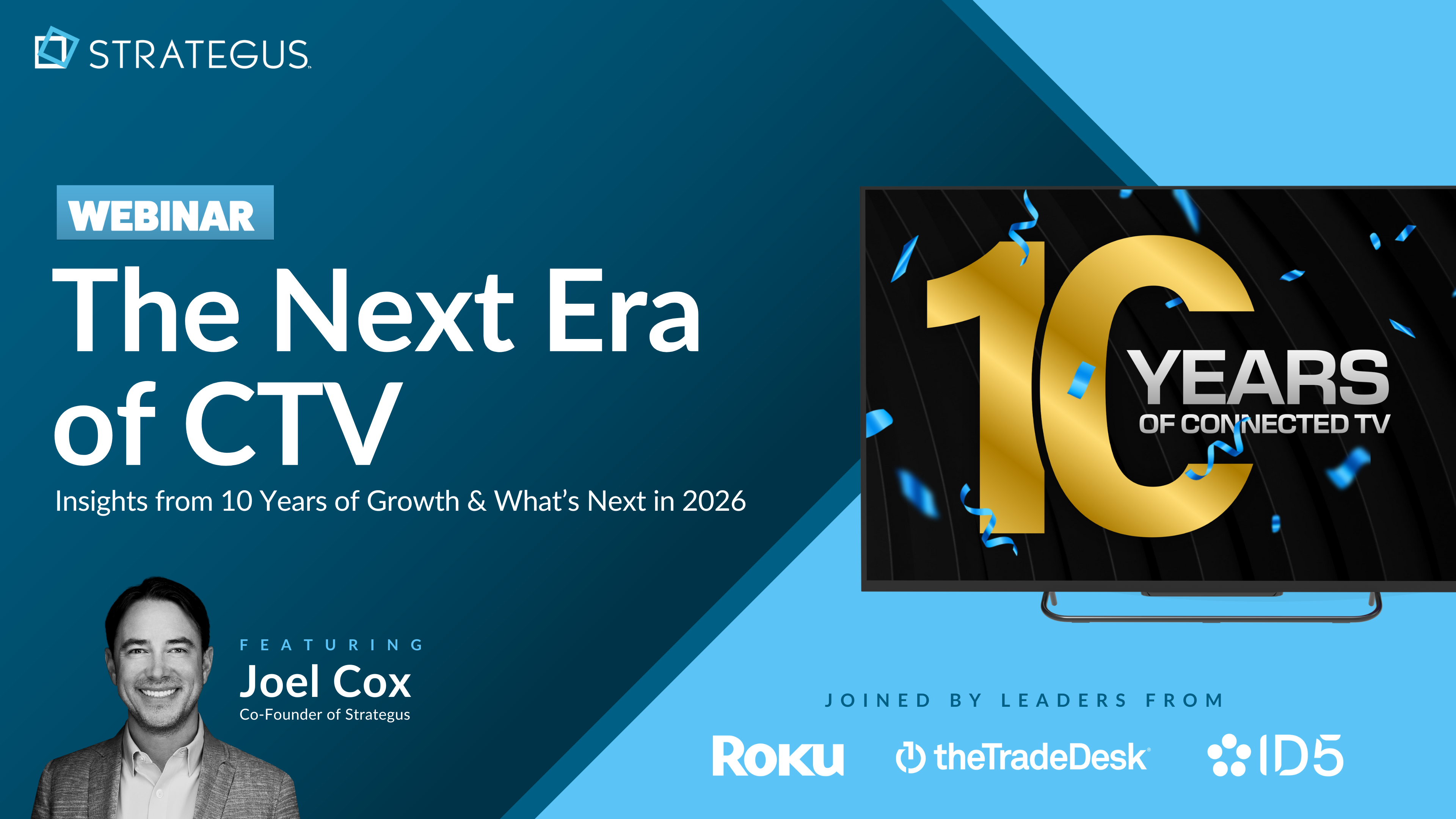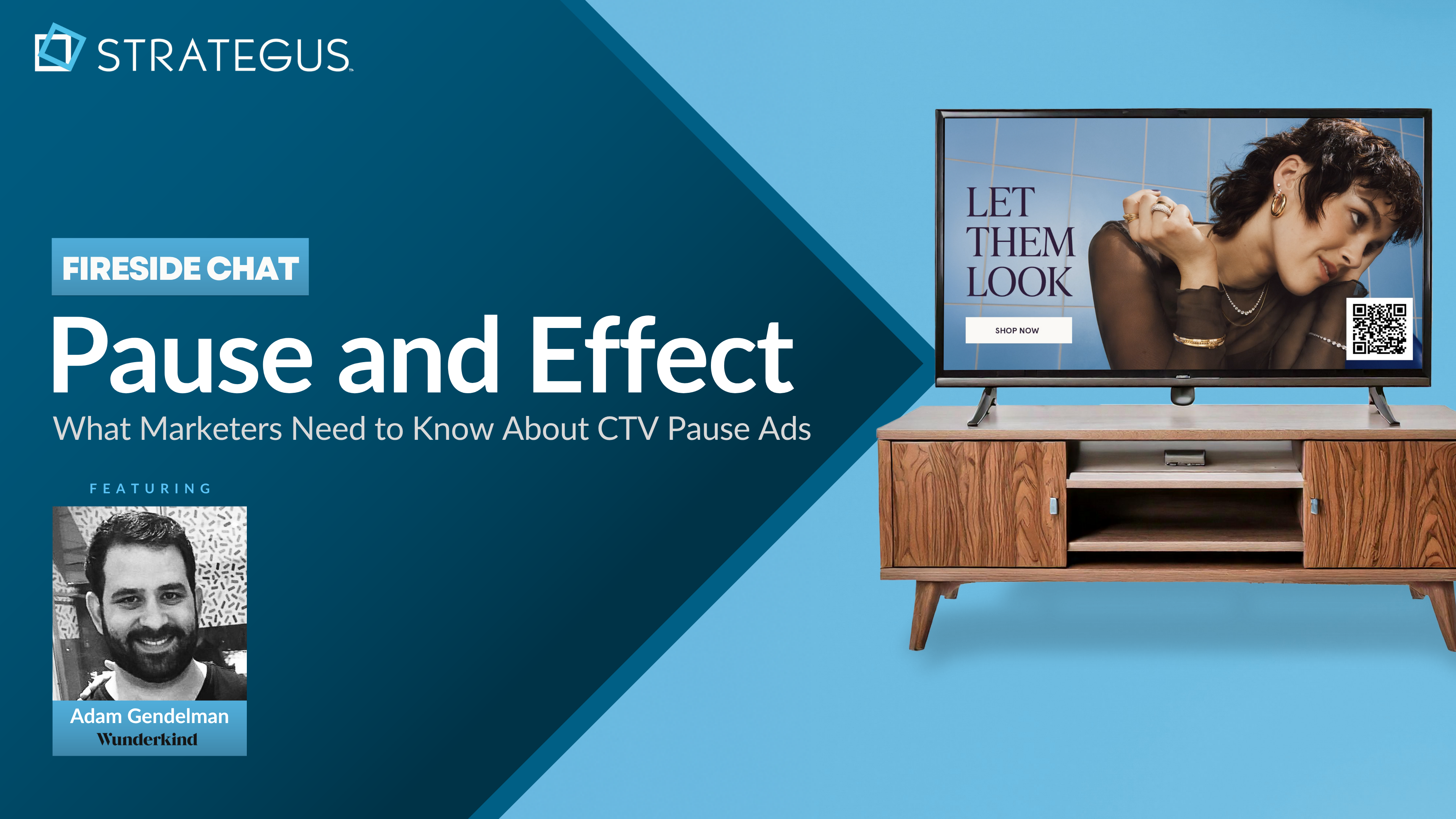- Home
- Strategus Blog
- What Is Addressable TV Advertising and How Does It Work (2025 Guide)
What Is Addressable TV Advertising and How Does It Work (2025 Guide)
 Traci Ruether
Traci Ruether
8 minutes read

Old-school TV ads showed the same message to everyone. No targeting. Lots of waste.
Addressable TV fixes that. It delivers different ads to different households, based on real viewer data.
With streaming and connected TV on the rise, addressable advertising is now the smart way to reach the right audience. This guide explains how it works and why it matters.
What Is Addressable TV Advertising?
Addressable TV advertising is a form of targeted TV advertising that allows advertisers to deliver ads to specific households or individuals. Thanks to programmatic technology, advertisers can pinpoint who sees their ads based on demographics, interests, viewing habits, buying behavior, and more.
Unlike traditional TV, which broadcasts the same ads to all viewers, addressable TV advertising allows for a more personalized and targeted approach. This means that different households watching the same program may see unique ads based on their specific characteristics and interests.
5 Addressable TV Advertising Examples
Addressable TV lets advertisers serve different ads to different households—even when they’re watching the same program. Below are real-world examples that show how brands use this precision to drive results:
- Automotive Campaigns: A car dealership runs an ad for a luxury SUV to high-income households, while showing a family-friendly minivan to parents, all during the same CTV show.
- Retail Retargeting: A user browses a sneaker brand’s website but doesn’t buy. That evening, they see a CTV ad highlighting the exact pair they viewed, complete with a personalized discount link.
- Healthcare Advertising: A health clinic targets ads for flu shots to local households with seniors or young children, based on household composition and ZIP code data.
- Restaurant Promotions: A national fast-food chain uses weather-triggered targeting, showing hot coffee ads on cold mornings in Boston and iced drinks in sunny Phoenix.
- Streaming Platform Cross-Sell: A media company promotes its drama series to users who watched similar content, while comedy fans get ads for its latest sitcom on the same streaming app.
These examples show how addressable TV replaces guesswork with data-driven accuracy. The result? Better engagement, higher ROI, and ads that actually matter to viewers.
How Does Addressable TV Advertising Work?
Unlike traditional linear TV, which targets viewers based on the programs they’re watching, addressable TV takes an audience-centric approach to ad placements. This is achieved using programmatic CTV technology, which relies on first- and third-party data to identify specific households.
Here’s a breakdown of the process:
- Data collection: Data is collected from various sources, such as first-party CRM data, Amazon purchase data, and connected TV viewing habit data. These sources are combined to provide information about viewers’ demographics, interests, and viewing habits.
- Audience segmentation: Using this data, advertisers segment their audience into different groups based on their characteristics and interests. This allows them to create targeted ads that are more likely to resonate with each group.
- Ad delivery: Once the audience is segmented, the targeted ads are delivered to specific households through their CTV screens. These ads run during streaming content like on-demand shows on Amazon Prime, live sports broadcasts on YouTube TV, and must-watch TV shows on DirecTV Stream.
- Measurement and optimization: Advertisers are then able to track the performance of their ads and make adjustments based on the data collected. This paves the way for continuous optimization that can be done on the fly.
Addressable TV vs Programmatic TV: Are They the Same?
No, addressable TV and programmatic TV are not the same, but they often work together.
Addressable TV refers to the ability to serve different ads to different households watching the same content, based on data like demographics, behavior, and location. It's about who sees the ad.
On the other hand, Programmatic TV refers to the automated buying and selling of TV ad inventory using software. It’s about how ads are bought and delivered, often in real time.
Simply put:
- Addressable = targeted delivery to specific households
- Programmatic = automated, data-driven media buying
Many CTV campaigns use programmatic platforms to buy addressable inventory, making them complementary strategies in advanced TV advertising.
4 Reasons Why Addressable TV Outperforms Traditional Ads
Addressable TV advertising benefits viewers, media buyers, and streaming platforms.
More relevant and personalized viewing experiences? Check. Lower costs and better performance for advertisers? Check. More transparency into results? Check.
Here’s a look at why addressable TV advertising is so compelling to media buyers and marketing leaders:
- Targeted reach: With addressable TV advertising, advertisers can reach specific households or individuals, ensuring that their ads are seen by the right audience.
- Personalization: By targeting specific households or individuals, advertisers can create personalized ads with nuanced messaging that’s likely to resonate with unique audience segments.
- Cost-effective: Advertisers only pay for the ads that are delivered to their target audience, making it a more cost-effective option.
- Measurable results: Addressable TV advertising allows for more accurate measurement of ad performance, providing advertisers with valuable data that can be used to optimize their campaigns.
How Is Addressable CTV Different from Traditional TV Advertising?
Rather than broadcasting expensive and irrelevant commercials to countless viewers, addressable programmatic CTV allows businesses to reach likely buyers with sophisticated campaigns.
Strategus EVP and Co-founder Joel Cox explains:
“Programmatic advertising brings new capabilities to more mid-market companies who can now afford more precise targeting, and therefore more accessible budgeting and reach. The opportunities for more advertisers are democratized by new technology. We want to move the market more toward where it should go, where ads are targeted to individuals in the audience, who see ads that are relevant to them, as opposed to the old way, where ads are targeted more toward the content that people are watching.
The data-driven approach makes so much more sense as the content is exploding with digital streaming over the internet. Serving relevant ads to the right people at the right time is where the advertising industry has wanted to go for generations.”
It’s also worth noting that streaming has surpassed traditional TV in terms of viewership, so allocating ad budget to programmatic CTV is a must at this stage of the game.
Smart Strategies for Addressable TV Advertising
Addressable TV advertising can be used in a variety of ways to achieve different advertising goals. Here are some examples of how advertisers can target niche audiences on the living room TV:
- Website retargeting: Reengage warm leads on the big screen and lure online shopper back to their abandoned carts. This keeps your brand top of mind after leads step away from the computer.
- First-party data targeting: Leverage customer data from your CRM to deliver personalized CTV ads directly to your contacts’ living rooms.
- Lookalike modeling: Expand your reach by building custom lookalike audiences. This powerful tactic is our second-best performer for driving results.
- Location-based retargeting: Reconnect with users who‘ve visited your stores — or conquest foot traffic from competitor locations. Both are powerful tactics to translate physical touchpoints into digital engagement.
- Smart audience contextual: Reach consumers actively researching your services by targeting viewers based on the websites they’ve been visiting and keywords they’ve been typing into Google.
- ACR data targeting: Reach specific households based on their TV viewing habits and interests for precise audience alignment. This could mean showing an ad for a Lexus convertible on its way to a golf course to a viewer who regularly watches live golf.
- Linear TV extension: Bridge the gap between your linear TV campaigns and CTV by targeting households exposed to your TV ads for increased reach and frequency. A combination of both mediums ensures that your efforts aren’t siloed.
- Amazon data targeting: Leverage Amazon purchase data to reach consumers actively shopping for products related to your campaign. For instance, a person who often purchases gluten-free products may see a commercial for a local health store.
Unlock the Full Power of Addressable TV with Strategus
At Strategus, we help brands unlock the full potential of addressable TV with expert-led, data-driven CTV campaigns. Whether you're just starting out or scaling complex initiatives, we simplify the process and maximize your return.
Here’s what you get when you partner with Strategus:
- Fully managed CTV campaigns tailored to your audience, goals, and KPIs
- Advanced targeting capabilities using first-party, ACR, Amazon, and geolocation data
- Custom dashboards and attribution tools to track ROI and optimize in real time
- Cross-device and omnichannel strategies to unify your ad efforts across screens
- Expert support on demand, with a team that acts as an extension of yours
Let us show you how precise, performance-driven addressable TV advertising should work.
Contact us for a free consultation.
Frequently Asked Questions
How Can You Better Target Your Audience Through TV Advertising?
You can target your audience more effectively by using first-party data, behavioral insights, geolocation, and lookalike modeling. Combine these with programmatic tools to serve tailored ads to specific households. The more accurate your data segments, the more relevant your ads become, boosting engagement and conversions.
Does the Style of Your TV Campaign Matter?
Yes, the style directly affects how viewers respond. Strong visuals, clear messaging, and relevance to the viewer's interests improve performance. Match your creative tone to the audience's preferences and viewing context. A well-matched style increases recall, emotional connection, and the chance viewers will take action.
How to Optimize Addressable Spend?
Start by focusing spend on high-performing segments. Use real-time data to adjust targeting and frequency. Test different creatives and placements to identify what drives results. Avoid overspending on low-converting audiences. Regularly review performance metrics and shift budget toward campaigns that deliver the highest return.
What Is Programmatic TV Advertising?
Programmatic TV advertising automates the buying and selling of TV ad space using software. It uses real-time bidding and audience data to place ads efficiently. This allows advertisers to reach specific viewers across multiple platforms with precision, often saving time and improving overall campaign performance.
How Does Programmatic TV Buying Work?
Programmatic buying uses demand-side platforms (DSPs) to purchase ad inventory in real time. It analyzes audience data, sets targeting rules, and bids for ad space automatically. When a viewer matches the criteria, the system delivers the ad instantly. This method ensures efficiency and smarter budget use.
How Do TV Advertisers Know Who Is Watching Certain TV Programs?
Advertisers use data from smart TVs, set-top boxes, ACR technology, and streaming platforms. These tools collect information about viewer behavior, household demographics, and content preferences. By matching this data with external sources, advertisers can understand who watches what and deliver relevant ads to the right viewers.
What Is Addressable Media?
Addressable media refers to any advertising channel that lets you target specific individuals or households. It includes channels like CTV, mobile, and digital out-of-home. Unlike broad media, addressable formats use data to serve relevant ads, which increases efficiency and helps brands reach high-value audiences directly.
What Is Addressability in Advertising?
Addressability in advertising means the ability to deliver different messages to different audience segments based on data like demographics, behavior, or location. It lets advertisers move away from mass messaging and focus on reaching the right person with the right message at the right time.
Does TV Advertising Work in Today's Digital Landscape?
Yes, especially with addressable and programmatic options. TV ads now offer better targeting, cross-device measurement, and strong brand impact. When paired with digital tools, TV advertising reaches engaged viewers and complements other channels, making it a powerful part of any media mix.
What Makes a Good Advertisement for Addressable TV?
A strong addressable TV ad speaks directly to the viewer's needs. Use personalized messaging, high-quality visuals, and clear calls to action. Keep the creative short and focused. Test variations based on audience segments and refine the message to match viewer behavior, interests, or purchase intent.

Traci Ruether is a content marketing consultant specializing in video tech. With over a decade of experience leading content strategy, she takes a metrics-driven approach to storytelling that drives traffic to her clients' websites. Follow her on LinkedIn at linkedin.com/in/traci-ruether or learn more at traciruether.com.
Strategus is a managed services connected TV(CTV) advertising agency with over 60,000+ campaigns delivered. Find out how our experts can extend your team and drive the result that matter most.
Talk to an Expert
Table of Contents
Seeking a Custom CTV Strategy That Delivers?
What to read next
App Event Tracking: Tie Mobile App Activity to CTV Campaigns
Let’s say you’re running a CTV campaign for a personal finance app.
5 minutes read

Stop Guessing Who Your Audience Is — Let Their Apps Tell You
Connected TV (CTV) targeting often falls in one of two camps.
8 minutes read
See Who Bought After Your Ad + How Much They Spent
You can’t improve what you can’t measure. And for years, that’s been a major problem with TV advertising.
4 minutes read

First-Party Attribution: Match Ads to Sales With CRM Data
The value of first-party data continues to grow.
7 minutes read













